The At Home Naturalist: Nature Journaling
/Last post I talked about how you can get involved in nature and even help with scientific research through the use of technology. I know that using technology is not for everyone especially when it comes to enjoying time in nature. Taking a walk or spending time in your backyard is also a great time to “unplug” and enjoy your surroundings. Through this post I will share some tips to get you started with another great way to be a naturalist at home: nature journaling.
Audubon picture of a Barred Owl Photo: www.audubon.org
The great thing about nature journaling is it can look however you want it to. You can fill it with sketches, painting, poetry, stories, etc. You also can be more scientific, documenting your observations on appearance and behavior, as well as taking measurements. Fill your journal with some combination writings, drawings, photography (this one does require a little technology though). If you don’t mind the use of a little technology, you could also make a video journal. You can also push yourself to work on a new skill or improve an old one.
Nature journaling in some form is at the heart of what it means to be a naturalist. A naturalist is a person who studies and shares about the natural world around us. Some famous naturalists include: John James Audubon who documented many species of birds including discovering new ones through his paintings, Charles Darwin whose observations and journaling led to ideas on natural selection, Rachel Carson who wrote articles and books to teach people about natural history and warned of the effect pesticides have the environment, and David Attenborough who writes and narrates documentaries that helps bring nature around the world to our televisions. All naturalists have a way of documenting and sharing their knowledge and observations with others.
Starting your Nature Journal
Like I have been saying, there are numerous ways to make a nature journal but a great way to start is to start practicing your observation skills. To start practicing this, what you will need is some paper, a writing utensil and a simple nature object like a rock, stick, leaf, or flower. Remember not to pick anything off of living plants. Sit somewhere comfortable where you can look at this object for a while. Start using your senses to make observations about your object. Write these down. You can also draw your object and label the observations you are making. What is the shape? Colors? Textures? What does it smell like? What sound does it make? Even if it feels like a silly observation, write it down. Once you have observed all that you can, look for more maybe from a different angle. Then spend some time writing down questions you have about it, even if they are silly. You can also write things that the object reminds you of.
The next time you journal, try a new object or maybe do this for a bird in your yard or an invertebrate you find under a log. It is important to keep going even if you feel silly because the more you practice, you will become more observant. Through this, you can learn a lot about the natural world around you. You also do not need to know the names of things or what even they are, just focus on using your senses. You can share your findings with your friends and family or keep them to yourself.
Other important things you can include in each journal entry include: the date, time, exact location, and weather.
You can also add some nature related poetry, art, leaf rubbings, printed photos. Don’t worry about any of your work being “good.” What really matters is that your journal connects you with nature and you gain some new observations or knowledge from doing so. Just remember to leave no trace and leave nature as you found it!
John Muir Laws, a fantastic naturalist and nature journaling expert, has some great resources, tips and drawing lessons on his website: https://johnmuirlaws.com/





